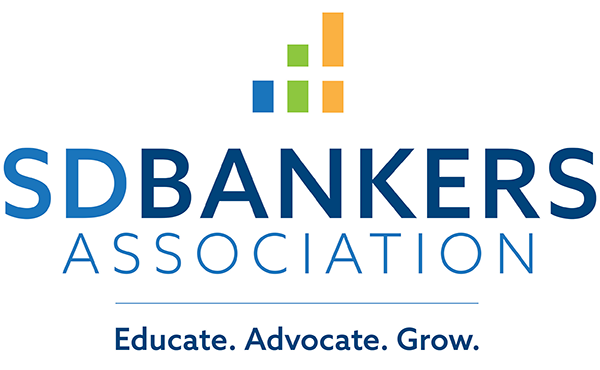- Education & Events
- Advocacy
- Products & Services
- Membership
- Resources
- SDBANKER Magazine
- SDBA eNews
- SDBA eNews Archives
- Legislative Update/Bill Watch
- South Dakota Bank Directory
- Women in Banking
- Scenes of South Dakota Calendar*
- Holiday Signs
- Regulatory Report
- South Dakota Banking Code
- Record Retention Manual
- Advertising & Sponsorship Guide
- COVID-19 Resources
- Mental Health and Crisis Prevention
- About
|
New CDC Order Temporarily Suspends Evictions Through Oct. 3As COVID-19 cases—including those connected to the Delta variant—continue to spike, the Centers for Disease Control and Prevention on Tuesday issued a new order directing evictions to be suspended through Oct. 3, “in counties with heightened levels of community transmission.” The CDC said that the order is “intended to target specific areas of the country where cases are rapidly increasing, which likely would be exacerbated by mass evictions.” The CDC’s earlier nationwide eviction moratorium expired on July 31. The order had been upheld by a 5-4 decision in the Supreme Court early in July, although one justice voting to uphold it said he agreed with a lower court ruling overturning the moratorium but allowing it to continue since it would expire in a few weeks. The new moratorium—coming after Congress failed to pass a bill authorizing it—is expected to face legal challenges. Read the order. USDA, HUD, VA and FHFA Announce Extension of Eviction Moratoria
The Department of Agriculture, Department of Housing and Urban Development, Department of Veterans Affairs and the Federal Housing Finance Agency announced late Friday that at the request of the Biden administration, they would extend their foreclosure-related eviction moratoria until Sept. 30, 2021. This announcement came just ahead of the expiration of the Centers for Disease Control and Prevention’s eviction moratorium on July 31. The agencies encouraged owners and operators of federally assisted and financed rental housing to “make every effort to access Emergency Rental Assistance resources to avoid evicting a tenant for non-payment of rent. These resources are available in every state, and many counties and cities are also running local programs.” Read more.
OCC's Hsu Says CRA Modernization on 'Aggressive Timeline'Testifying before the Senate Banking Committee on Tuesday, Acting Comptroller of the Currency Michael Hsu said that the OCC has aggressive internal timelines for working with the Federal Reserve and FDIC to put forward a joint rulemaking that strengthens and modernizes the Community Reinvestment Act. “The teams are working very quickly,” Hsu said. "We have given internal, kind of aggressive timelines on that, but it is a complicated rule and we want to make sure that we do it right and we will be working with all deliberate speed.” He later added that “we currently have groups that are working pretty much around the clock on coming up with options to strengthen the CRA to make sure that low and moderate-income communities have their needs met.” Separately, FDIC Chairman Jelena McWilliams identified inflation, cybersecurity and commercial real estate as key risk factors for banks. “With the new normal and how the pandemic changes the ability of people to work, what does that mean for the bottom line for banks and the commercial properties?” she remarked. Watch the hearing. ABA's Paul Benda Reviews Delta Safety Precautions, Vaccine EffectivenessOn the latest ABA Pandemic Update, ABA’s SVP Paul Benda breaks down the science behind the Delta variant's hyper-infectious nature—and how things keep getting worse and are likely to get worse before getting better. Benda reviews vaccine effectiveness with Delta; the breakthrough Provincetown, Mass., cluster; and how to mitigate the risk of getting infected. Listen to the episode. Bankers can also subscribe to the ABA Pandemic Update through the following podcast apps: Apple Podcasts, Google Podcasts, Stitcher, or Amazon Audible. ABA Opposes Proposed Changes to Fed's Payment System Risk PolicyThe ABA on Monday expressed opposition to several proposed changes to the Federal Reserve’s payment system risk policy. In a letter to the Fed, ABA raised concerns over parts of the proposal that would provide benefits to participants in FedNow—the real-time payments network the Fed is developing and expects to launch in 2023—over financial institutions that choose not to adopt it. Specifically, the association opposed higher daylight overdraft expenses that would be based on a 24-hour day, regardless of whether institutions would have around-the-clock access via FedNow. The ABA emphasized that “the current fee calculations should remain unchanged for those institutions without 24-hour access. This policy should be a temporary one and revisited when all financial institutions become operable on a 24-hour basis.” The ABA also opposed a proposal to link the Liquidity Management Tool (LMT) the Fed is developing to FedNow Services. Rather, the ABA called for the LMT to be “operated independently of FedNow services and made available to all financial institutions as soon as possible.” The ABA expressed support for certain parts of the proposal, including those that would expand the scope of financial institutions eligible to apply for intraday credit and streamline the process, with the condition that each application be subject to extensive review—especially those with novel charters that do not have the same level of oversight as traditional financial institutions. Read the letter. For more information, contact ABA's Steve Kenneally.
ABA Seeks Feedback on Bank On Certification ProcessAs ABA encourages all banks to consider offering a Bank On-certified account, the Association is asking banks that have already completed their certification, or are in the process of pursuing it, for feedback about their experience with the Bank On certification process. Bank On certified accounts provide benefits to both banks and customers by bringing more people into the banking system and connecting them with low-cost, full-service accounts. The ABA is seeking feedback to help smooth the path as the industry continues to expand the Bank On certification. Submit feedback to [email protected]. ABA Refreshes #BanksNeverAskThat Campaign for 2021Registration is now open for banks of all sizes to participate in the second iteration of ABA’s award-winning #BanksNeverAskThat anti-phishing campaign. Created on 2020 to help consumers fight phishing fraud, last October’s #BanksNeverAskThat campaign saw nearly 1,700 banks participating. This year ABA hopes to recruit even more banks to join the industry-wide effort. Through the combined efforts of the ABA and participating banks, more than 200,000 people visited BanksNeverAskThat.com to learn about phishing tactics, and 52,000 people tested their scam spotting skills, while sharing their knowledge with thousands of others. This year's campaign kicks off Oct. 1 as part of National Cybersecurity Awareness Month. BanksNeverAskThat.com will be refreshed to include a new interactive quiz for consumers. In late August, participating banks will have access to an updated toolkit full of ready-to-use graphics, social posts, digital signage, printables and more. Participation is free for every bank regardless of ABA membership. Register now. For more information, contact [email protected].
SD Land and Lending Conference to be Held Sept. 10The SDSU Ness School of Management and Economics is bringing together business-savvy, innovative minds—lawyers, brokers, lenders, appraisers, abstracters and more—to learn, grow and explore development possibilities in South Dakota. The inaugural South Dakota Land and Lending Conference will be held Sept. 10, 2021, in Sioux Falls at the Denny Sanford PREMIER Center. This full-day summit will include engaging keynote speakers and panel discussions, breakout sessions and networking opportunities. The cost is $50 per person and $25 for students. Learn more and register.
Question of the Week
Question: The bank offers a service that allows funding new accounts through an ACH transfer authorized from the bank. For example, customer is opening a new account at Bank B and has an existing account at Bank A. Our service allows the customer to authorize Bank B (us) to debit Bank A when funding a newly established account. Must our bank make these funds available within two business days under Regulation CC? We are concerned with fraudulent funding that Bank A may have the right to revoke from us, after the customer funded their new account and withdraws the funds. Answer: The funding of the new account is an ACH debit, instead of credit, under Regulation CC; and therefore, is not covered by the Regulation. Accordingly, the funds availability for this type of ACH transfer is governed by the bank account agreement with Bank A, which can be delayed for a reasonable amount of time, until the bank can determine that the transfer was not fraudulent. Regulation CC, § 229.10(b), requires making an electronic payment available for withdrawal within two business days after receiving the funds. Additionally, § 229.2(p), defines electronic payment to mean, in part, “an ACH credit transfer.” And § 229.2(b), defines an ACH to mean, in part, a facility that processes debit and credit transfers. Further, the commentary to § 229.2(b), clarifies that in an ACH credit transfer, the originator orders that its account be debited and another account credited. In an ACH debit transfer, the originator, with prior authorization, orders another account to be debited and the originator’s account to be credited. In the question, the originator is indeed ordering another account debited and the originator’s account credited. Accordingly, the originator is making an ACH debit transfer, which is not an electronic payment under Regulation CC; and therefore, is not subject to the two-day funds’ availability requirement. Electronic payments—(1) In general. A bank shall make funds received for deposit in an account by an electronic payment available for withdrawal not later than the business day after the banking day on which the bank received the electronic payment. Regulation CC, § 229.10(b), https://www.ecfr.gov/cgi-bin/text-idx?SID=1b93d21e8747bf42176b8d0016c97f43&mc=true&node=se12.3.229_110&rgn=div8 Electronic payment means a wire transfer or an [ACH credit] transfer. Regulation CC, § 229.2(p), https://www.ecfr.gov/cgi-bin/text-idx?SID=1b93d21e8747bf42176b8d0016c97f43&mc=true&node=se12.3.229_12&rgn=div8 Automated clearinghouse or ACH means a facility that processes debit and credit transfers under rules established by a Federal Reserve Bank operating circular on automated clearinghouse items or under rules of an automated clearinghouse association. Regulation CC, § 229.2(b), https://www.ecfr.gov/cgi-bin/text-idx?SID=c01c9a69022b2017f50ff88b61b34147&mc=true&node=se12.3.229_12&rgn=div8 The reference to “debit and credit transfers” does not refer to the corresponding debit and credit entries that are part of the same transaction, but to different kinds of ACH payments. In an ACH credit transfer, the originator orders that its account be debited and another account credited. In an ACH debit transfer, the originator, with prior authorization, orders another account to be debited and the originator's account to be credited. Appendix E to Part 229—Commentary C2, https://www.ecfr.gov/cgi-bin/text-idx?SID=1b93d21e8747bf42176b8d0016c97f43&mc=true&node=ap12.3.229.0000_0nbspnbspnbsp.e&rgn=div9 Not a member? Learn more about membership with Compliance Alliance by attending one of our live demos: Compliance Alliance offers a comprehensive suite of compliance management solutions. To learn how to put them to work for your bank, call 888.353.3933 or email and ask for our Membership Team. For timely compliance updates, subscribe to Bankers Alliance’s email newsletters. SDBA eNews Archive Advertising Opportunity Questions/Comments |



